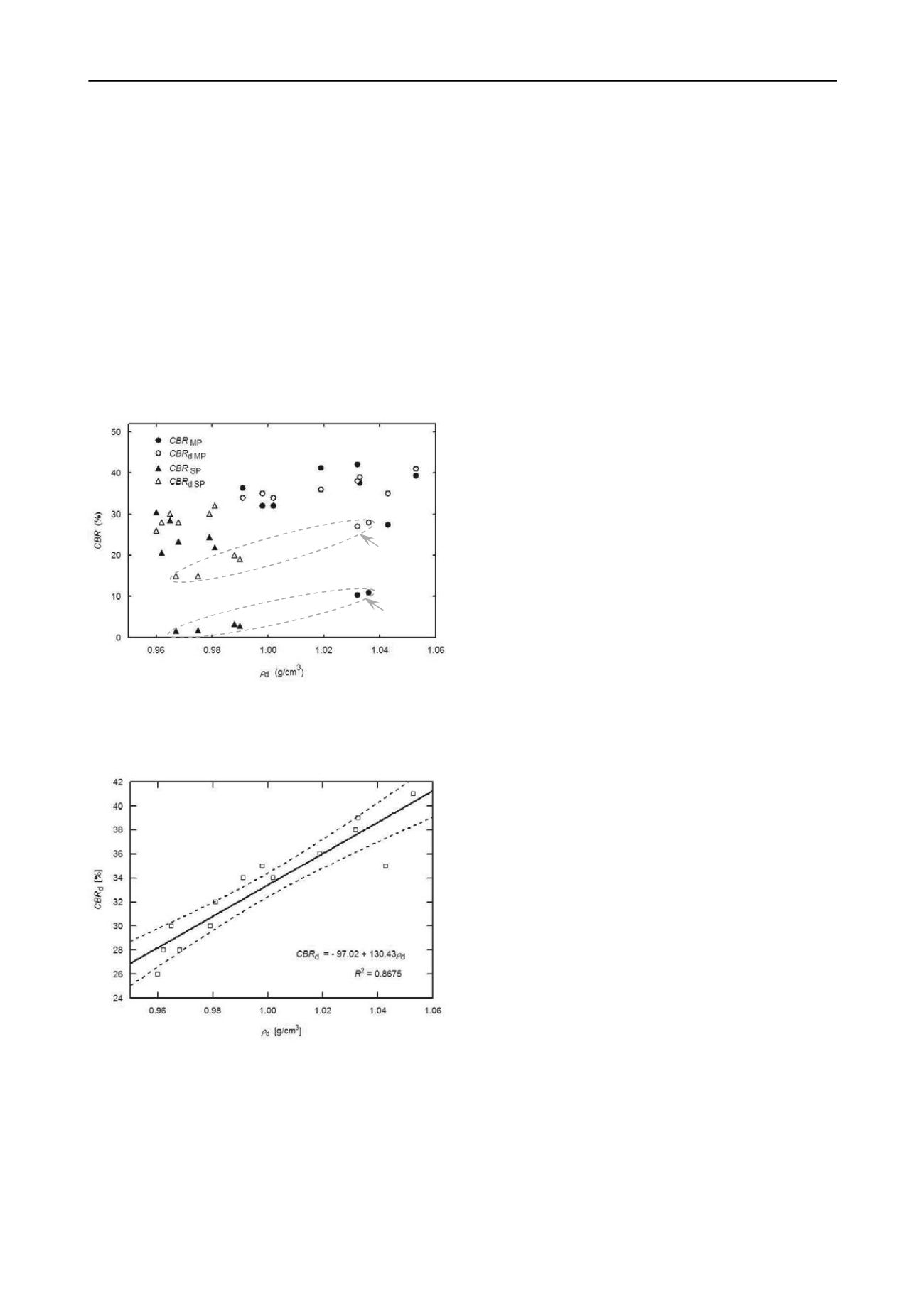
644
Proceedings of the 18
th
International Conference on Soil Mechanics and Geotechnical Engineering, Paris 2013
dissipation in the case of impact loading. Similar observations
can be made during studies on the influence of penetration ratio
on the resistance of saturated clayey soils in cone penetration
tests (Kim et al. 2008).
Figure 3 presents dependence of static and dynamic
CBR
on
dry density. It can be seen in Figure 3 that there are points
standing out, with the coordinates (
ρ
d
,
CBR
) obtained in the case
of standard method at moisture content higher than optimum by
at least 2.5%, and in modified method higher by at least 5%.
This is the result of dependence of mechanical parameters of fly
ash on moisture content in the process of compaction. Once
these points are excluded, statistically valid relationships -
CBR
(
ρ
d
) can appear, especially in the case of
CBR
d
values,
where for value
CBR
d
(
ρ
d
) coefficient of determination
R
2
=0.8675 was obtained (Fig. 4).
CBR
d
dependence on
CBR
is
also statistically valid. Equation
CBR
d
=17.28+0.52
CBR
explains 84.9% of variance in the value of statistic
CBR
.
Figure 3. Relationship between
CBR
value and dry density with an
indication the points obtained at moisture contents at compaction
w
=
w
opt
+(2.5–5%): MP – Modified Proctor method, SP – Standard
Proctor method,
CBR
– static test results,
CBR
d
– dynamic test results.
Figure 4.
CBR
value versus dry density excluding the points obtained at
moisture contents at compaction
w
=
w
opt
+(2.5–5%), along with 95%
confidence interval.
3 CONCLUSIONS
1. The dynamic
CBR
method, as well as static (classic)
method can be used to assess compaction of fly ash and
cohesive soils embedded in subgrade or layers of
embankment. The results of studies of
CBR
d
, and
CBR
, are
closely connected with the characteristics of compaction.
2. The current compaction quality control of fine grained
anthropogenic ground conducted through
CBR
d
tests with
the use of Light Weight Deflectometer producing a defined
load pulse of the
CBR
piston is recommended in the cases
of embedded material at moisture contents equal optimum
or lower.
CBR
d
studies of anthropogenic ground compacted
at moisture levels exceeding optimum water content may
lead to overstating of the test results due to lack of pore
pressure dissipation after impact ground loading.
3. Dynamic
CBR
test, using Light Weight Deflectometer,
should be widely used due to its speed and ease of research
as an alternative method to classic method of quality
control in compaction process or assessment of subgrade
bearing capacity.
4 ACKNOWLEDGEMENTS
This work, carried out in 2012 at the Bialystok University of
Technology, was supported by Polish financial resources on
science. The authors gratefully acknowledge the assistance and
cooperation of M. Piasecki and D. Tymosiak who performed the
laboratory tests.
5 REFERENCES
Turnbull W.J. and Foster Ch.R. 1956. Stabilization of materials by
compaction.
Journal of Soil Mechanics and Foundations Division
82 (SM2), 1-23.
Mitchell J.K., Hooper D.R., Campanella R.G. 1965. Permeability of
compacted clay.
Journal of Soil Mechanics and Foundation
Division
91 (SM4), 41-63.
Zabielska-Adamska K. 2006.
Fly ash as a material for constructing
sealing layers.
Publishing House of BTU, Bialystok. (in Polish)
Zabielska-Adamska K. 2011. Fly ash as a barrier material. In:
Geo
‐
Frontiers 2011 “Advances in Geotechnical Engineering”
,
ASTM STP 211, ASTM Int., PA, 947-956.
Sulewska M.J. 2012. The control of soil compaction degree by means of
LFWD.
Baltic Journal of Road and Bridge Eng
.
7(1), 36-41.
Brown S.F. 1996. Soil mechanics in pavement engineering.
Géotechnique
46 (3), 383-426.
Zorn. 2002. Operating Manual. Light Drop-Weight Tester ZFG 05 for
the dynamic CBR test and the dynamic plate loading test. Gerhard
Zorn Mechanische Werkstatten, Stendal.
Rico Rodrigues A., del Castillo H. and Sowers G.F. 1988.
Soil
mechanics in highway engineering
. Trans Tech Publication,
Clausthal-Zellerfeld.
Faure A.G. and Viana Da Mata J.D. 1994. Penetration resistance value
along compaction curve.
Journal of Geotechnical Engineering
120
(1), 46-59.
Aiban S.A. 1995. Strength and compressibility of Abqaiq marl, Saudi
Arabia.
Engineering Geology
39 (3-4), 203-215.
Zabielska-Adamska K. and Sulewska M.J. 2009. Neural modelling of
CBR values for compacted fly ash. In:
Proc. 17th Intern. Conf. on
Soil Mechanics and Geotechnical Engineering
, Eds. M. Hamza, M.
Shahien, Y. El-Mossallamy, IOS Press - Millpress, Vol. I, 781-784.
Weingart W., Hanebutt J. and Rummert W. 1990. Dynamic laboratory
and field testing device for determination of the CBR value of
mineral concrete.
Die Strasse
26 (2), 48-51. (in German)
Schmidt H.-H. and Volm J. 2000. Dynamic CBR test – new method of
embankment quality control.
Geotechnik
23 (4), 271-274. (in
German)
Kim K., Prezzi M., Salgado R. and Lee W. 2008. Effect of penetration
rate on cone penetration resistance in saturated clayey soils.
Journal
of Geotechnical and Geoenvironmental Eng.
134 (8), 1142-1153.
dynamic
static


